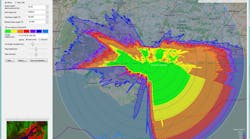For those seeking to learn more about the coverage offered by a particular radar system, a free software tool from Cambridge Pixel, the SPx Radar Coverage Tool, provides visualization of a radar system’s capabilities. It is a useful aid for finding the optimum location for a radar or other sensor working with line-of-sight detection.
The free-of-charge, Windows-based software is available for free download from the firm’s website. It is a time-saving tool for defense system integrators and security professionals seeking optimum coverage for a detection system. The proposed location of the radar may be entered directly as latitude and longitude, or the operator can simply click on a high-resolution map. The software calculates the visibility of targets at different heights based on the location and height of the radar.
“This is a really useful tool that our commercial security and defense customers have been asking for,” says David Johnson, CEO of Cambridge Pixel. “It is easy to use and provides a fast, interactive method of exploring the implications of different radar locations and heights.
“The Radar Coverage Tool will be helpful in a variety of radar surveillance applications,” he adds, “from coastal and air defense through to ground protection of military forward operating bases, large camps, observation posts and patrol bases where land features may provide blind spots in the radar coverage.”


